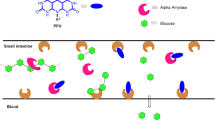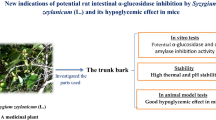Abstract
Diabetes mellitus is a metabolic disorder characterized by high blood glucose levels and instability in carbohydrate metabolism. For treating diabetes, one important therapeutic approach is reducing the postprandial hyperglycemia which can be managed by delaying the absorption of glucose through inhibition of the carbohydrate-hydrolyzing enzymes, α-amylase (α-Amy) and α-glucosidase (α-Gls) in the digestive tract. In this work, a new class of curcumin derivatives incorporating pyrano[2,3-d]pyrimidine heterocycles was synthesized using a multicomponent reaction between curcumin, aldehydes, and barbituric acid. Using UV-Vis spectroscopic method, the synthetic compounds were assessed for their inhibitory properties against α-Amy and α-Gls enzymes. Also, the antioxidant potential of these compounds was measured spectroscopically and compared with Trolox which is known as a gold standard to measure antioxidant capacity. The results of present study suggest that the curcumin derivatives were able to efficiently inhibit both yeast and mammalian α-Gls. In comparison with the antidiabetic medicine acarbose, the synthetic curcumin derivatives were also capable to inhibit more effectively the yeast α-Gls. The partial inhibitory effects of these compounds against pancreatic α-Amy were also important in the terms of avoiding development of the possible gastrointestinal side effects. Moreover, some of the curcumin derivatives indicated stronger antioxidant activity than Trolox. Overall, these synthetic curcumin analogues might be considered as novel molecular templates for development of efficient antidiabetic compounds with promising inhibitory activities against α-Amy and α-Gls enzymes.








Similar content being viewed by others
References
Funke I, Melzig MF. Traditionally used plants in diabetes therapy: phytotherapeutics as inhibitors of alpha-amylase activity. Rev Bras Farmacogn. 2006;16:1–5.
Abdollahi M, Ranjbar A, Shadnia S, Nikfar S, Rezaiee A. Med.Sci. 2004;10:141–7.
Rahimi R, Nikfar S, Larijani B, Abdollahi M. A review on the role of antioxidants in the management of diabetes and its complications. Biomed Pharmacother. 2005;59:365–73.
Jaiswal N, Srivastava SP, Bhatia V, Mishra A, Sonkar AK. J Diabetes Metab. 2012;6:2.
Carroll MF, Gutierrez A, Castro M, Tsewang D, Schade DS. Targeting postprandial hyperglycemia: a comparative study of insulinotropic agents in Type 2 diabetes. J Clin Endocrinol Metab. 2003;88:5248–54.
Choudhary MI, Basha FZ, Abbas G, Khan SN, Shah SAA. Pure Appl Chem. 2007;79:2263–8.
Chiba S. Molecular mechanism inα-glucosidase and glucoamylase. Biosci Biotechnol Biochem. 1997;61:1233–9.
Kim KY, Nam KA, Kurihara H, Kim SM. Potent α-glucosidase inhibitors purified from the red alga Grateloupia elliptica. Phytochem. 2008;69:2820–5.
Chiasson JL, Rabasa-Lhoret R. J Diabetes. 2004;53:34–8.
Dwek RA, Butters TD, Platt FM, Zitzmann N. Targeting glycosylation as a therapeutic approach. Drug Discov. 2002;1:65–75.
Bachhawat JA, Shihabudeen MS, Thirumurugan K. Int J Pharm Pharm Sci. 2011;3:267–74.
Konya H, Miuchi M, Konishi K, Nagai E, Ueyama T, Kusunoki Y, et al. Pleiotropic Effects of Mitiglinide in Type 2 Diabetes Mellitus. J Int Med Res. 2009;37:1904–12.
Sharma OP. Biochem Pharmacol. 1976;15:1811–2.
Oglah MK, Mustafa YF. Curcumin analogs: synthesis and biological activities. Med Chem Res. 2020;29:479–86.
Du ZY, Liu RR, Shao WY, Mao XP, Ma L, Gu LQ. α-Glucosidase inhibition of natural curcuminoids and curcumin analogs. Eur J Med Chem. 2006;41:213–8.
Panahi F, Niknam E, Sarikhani S, Haghighi F, Khalafi-Nezhad A. Multicomponent synthesis of new curcumin-based pyrano[2,3-d]pyrimidine derivatives using a nano-magnetic solid acid catalyst. New J Chem. 2017;41:12293–302.
Yousefi R, Alavian-Mehr MM, Mokhtari F, Panahi F, Mehraban MH, Khalafi-Nezhad A, et al. Med Chem. 2013;28:1228–35.
B. B. Aggarwal, Y. J. Surh, S. Shishodia, Springer Science and Business Media. 595 (2007).
Panahi F, Yousefi R, Mehraban MH, Khalafi-Nezhad A. Synthesis of new pyrimidine-fused derivatives as potent and selective antidiabetic α-glucosidase inhibitors. Carbohydr Res. 2013;380:81–91.
Cortes A, Cascante M, Cardenas ML, Cornish-Bowden A. Relationships between inhibition constants, inhibitor concentrations for 50% inhibition and types of inhibition: new ways of analysing data. Biochem J. 2001;357:263–8.
Re R, Pellegrini N, Proteggente A, Pannala A, Yang M, Rice-Evans C. Antioxidant activity applying an improved ABTS radical cation decolorization assay. Free Radic Biol Med. 1999;26:1231–7.
Wang H, Cao G, Prior RL, Agric J. Total antioxidant capacity of fruits. Food Chem. 1996;44:701–5.
O'Connor CJ, Beckmann HS, Spring DR. Diversity-oriented synthesis: producing chemical tools for dissecting biology. Chem Soc Rev. 2012;41:4444–56.
de Graaff C, Ruijter E, Orru RV. Recent developments in asymmetric multicomponent reactions. Chem Soc Rev. 2012;41:3969–4009.
Dömling A. Recent developments in isocyanide based multicomponent reactions in applied chemistry†. Chem Rev. 2006;106:17–89.
Panahi F, Yousefi R, Mehraban MH, Khalafi-Nezhad A. Synthesis of new pyrimidine-fused derivatives as potent and selective antidiabetic α-glucosidase inhibitors. Carbohydr Res. 2013;380:81–91.
Tavaf Z, Dangolani SK, Yousefi R, Panahi F, Shahsavani MB, Khalafi-Nezhad A. Synthesis of new curcumin derivatives as influential antidiabetic α-glucosidase and α-amylase inhibitors with anti-oxidant activity. Carbohydr Res. 2020;494:108069.
Gupta SC, Prasad S, Kim J, Patchva S, Webb LJ, Priyadarsini IK, et al. Multitargeting by curcumin as revealed by molecular interaction studies. Nat Prod Rep. 2011;28:1937–55.
Aggarwal BB, Kumar A, Bharti AC. Anticancer potential of curcumin: preclinical and clinical studies. Anticancer Res. 2003;23:363–98.
Anand P, Sundaram C, Jhurani S, Kunnumakkara AB, Aggarwal BB. Curcumin and cancer: An “old-age” disease with an “age-old” solution. Cancer Lett. 2008;267:133–64.
Anand P, Kunnumakkara AB, Newman RA, Aggarwal BB. Bioavailability of curcumin: problems and promises. Mol Pharm. 2007;4:807–18.
Anand P, Thomas SG, Kunnumakkara AB, Sundaram C, Harikumar KB, Sung B, et al. Biological activities of curcumin and its analogues (Congeners) made by man and Mother Nature. Biochem.Pharmacol. 2008;76:1590–611.
Kiuchi F, Goto Y, Sugimoto N. Studies on crude drugs effective on visceral larva migrans. Part XVI. Nematocidal activity of turmeric: synergistic action of curcuminoids. Chem Pharm Bull. 1993;41:1640–3.
Adams BK, Ferstl EM, Davis MC, Herold M, Kurtkaya S, Camalier RF, et al. Synthesis and biological evaluation of novel curcumin analogs as anti-cancer and anti-angiogenesis agents. Bioorg Med Chem. 2004;12:3871–83.
Qiu X, Du Y, Lou B, Zuo Y, Shao W, Huo Y, et al. Synthesis and identification of new 4-arylidene curcumin analogues as potential anticancer agents targeting nuclear factor-κB signaling pathway. J Med Chem. 2010;53:8260–96.
Yousefi A, Panahi F, Sarikhani S, Zolghadr AR, Bahaoddini A, Khalafi-Nezhad A. Novel curcumin-based pyrano[2,3-d]pyrimidine anti-oxidant inhibitors for α-amylase and α-glucosidase: Implications for their pleiotropic effects against diabetes complications. Int J Biol Macromol. 2015;78:46–55.
Tabatabaei-Malazy O, Larijani B, Abdollahi M. J Med Chem. 2013;7:25–30.
Jordan WC, Drew CR. J Natl Med Assoc. 1996;88:333–8.
Mahmmoud YA. Modulation of protein kinase C by curcumin; inhibition and activation switched by calcium ions. Br J Pharmacol. 2007;150:200–8.
Aldebasi YH, Aly SM, Rahmani AH. Int J Physiol.Pathophysiol.Pharmacol. 2013;5:194–9.
Kowluru RA, Kanwar M. J Clin NutrMetab. 2007;4:8–13.
Goda T, Suruga K, Komori A, Kuranuki S, Mochizuki K, Makita Y, et al. Effects of miglitol, an alpha-glucosidase inhibitor, on glycaemic status and histopathological changes in islets in non-obese, non-insulin-dependent diabetic Goto-Kakizaki rats. Br J Nutr. 2007;98:702–10.
Afifi AF, Kamel EA, Khalil AA, Fawzi MFEÍ, Housery MM. J Clin Nutr Metab. 2008;3:14–21.
Cho M, Han JH, You S. Br J Pharmacol. 2011;44:1164–71.
Kim KT, Rioux LE, Turgeon SL. Alpha-amylase and alpha-glucosidase inhibition is differentially modulated by fucoidan obtained from Fucus vesiculosus and Ascophyllum nodosum. J.Phytochem. 2014;98:27–33.
Abdollahi M, Ranjbar A, Shadnia S, Nikfar S, Rezaiee A. Med Sci Monit. 2004;10:141–7.
Rahimi R, Nikfar S, Larijani B, Abdollahi M. A review on the role of antioxidants in the management of diabetes and its complications. Biomed.Pharmacother. 2005;59:365–73.
Paine A, Eiz-Vesper B, Blasczyk R, Immenschuh S. Signaling to heme oxygenase-1 and its anti-inflammatory therapeutic potential. Biochem.Pharmacol. 2010;80:1895–903.
Abdollahi M, Tabatabaei-Malazy O, Larijani B. Res Rev J Pharm Pharm Sci. 2012;15:447–66.
Tavaf Z, Tabatabaei M, Khalafi-Nezhad A, Panahi F, Hosseini A. Green synthesis of silver nanoparticles by reduced glycated casein adducts: Assessment of their antibacterial and antioxidant activity against Streptococcus mutans. Eur JIntegr Med. 2015;7:294–302.
Kim KY, Nam KA, Kurihara H, Kim SM. Potent α-glucosidase inhibitors purified from the red alga Grateloupia elliptica. Phytochemistry. 2008;69:2820–5.
Acknowledgments
The authors appreciatively acknowledge the financial support of Shiraz University and National Institute for Medical Research Development (NIMAD).
Funding
This work was supported by NIMAD (grant number 964854).
Author information
Authors and Affiliations
Contributions
RY, FP and AK conceived and designed research. FP and MN synthesized and characterized synthetic compounds. FH and ZT conducted biological experiments. FP and RY analyzed data and wrote the manuscript. All authors read and approved the manuscript.
Corresponding authors
Ethics declarations
Conflict of interest
The authors declare that they have no conflicts of interest with the contents of this article.
Additional information
Publisher’s note
Springer Nature remains neutral with regard to jurisdictional claims in published maps and institutional affiliations.
Electronic Supplementary Material
ESM 1
(DOCX 973 kb)
Rights and permissions
About this article
Cite this article
Hasaninezhad, F., Tavaf, Z., Panahi, F. et al. The assessment of antidiabetic properties of novel synthetic curcumin analogues: α-amylase and α-glucosidase as the target enzymes. J Diabetes Metab Disord 19, 1505–1515 (2020). https://doi.org/10.1007/s40200-020-00685-z
Received:
Accepted:
Published:
Issue Date:
DOI: https://doi.org/10.1007/s40200-020-00685-z




